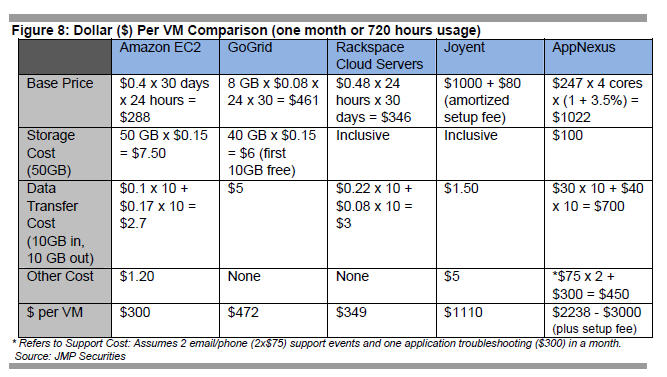Comparing infrastructure as a service providers: Amazon, Rackspace emerge

Amazon Web Services has the best pricing based on dollar per virtual machine, but Rackspace fills in a few gaps---especially with persistent instance data, according to a report from JMP Securities.
In the report, JMP analyst Patrick Walravens surveys the infrastructure as a service providers. The report, which admittedly isn't exhaustive, looks at a slice of cloud computing providers to highlight the available options. Walravens looked at Amazon Web Services, Rackspace, GoGrid, Joyent and AppNexus. Walravens' bottom line:
We found that Amazon Web Services offers the most competitive pricing on a dollar per virtual machine basis. Large companies have noticed and are using its Web Services cloud computing platform to host their public websites. Of the top 500,000 websites, 1,422 are hosted on Amazon’s EC2 service.
The big emerging player in the JMP Securites report is Rackspace. Walravens notes that Rackspace has an advantage over EC2 courtesy of its persistent instance data.
The Amazon vs. Rackspace analogy is a good one. In fact, Rackspace is likely to be more competitive. Walravens noted Rackspace's disadvantages and two of them---no API access and no Windows support---are being resolved.
Also see: Rackspace lays out its cloud computing roadmap: Think hybrid
The rest of the report highlights the key players--Amazon, GoGrid, Rackspace, Joyent and AppNexus. The overall message here is to read the fine print of these providers---features and pricing are all over the map.
A quick look at the pricing:
Add it up and pricing is all over the map. Walravens notes that it's difficult for buyers to compare pricing. He recommends reading the fine print to get a valid cost analysis. Here are few questions to ponder.
Determining specific project requirements:
- Figure out whether you need a single instance, public IPs, multicasting and your bandwidth needs.
Avoiding vendor lock-in:
- Ask if your image is portable, minimum lock-in periods and whether there is third party support.
Trusting the company as a critical infrastructure provider:
- Analyze whether these players have stable financials, SLAs and staying power.
